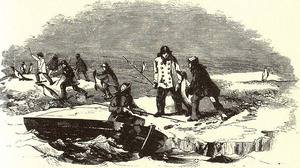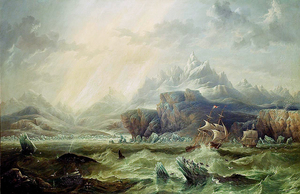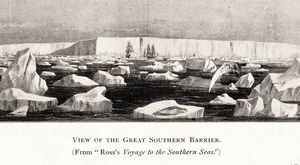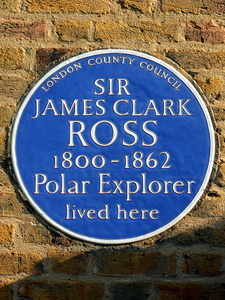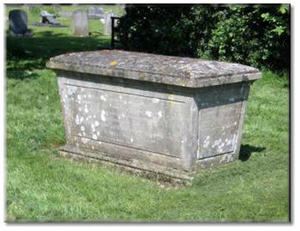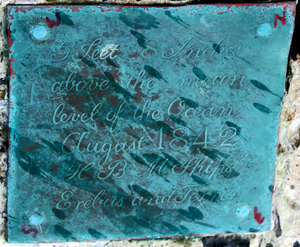ROSS, Sir JAMES CLARK
1800 - 1862 from England
rear admiral, Arctic and Antarctic navigator, was born in Finsbury Square, London, on 15 April 1800, son of George Ross and Christian, née Clark. George Ross, originally from Wigtonshire, traded as a 'Wine, Brandy and Porter Merchant'. One of three brothers and two sisters, the young James Clark Ross, along with his brothers, was educated as a boarder at Chislehurst Academy.
The North West Passage
On 5 April 1812, ten days before his twelfth birthday, Ross entered the Royal Navy as a first-class volunteer and joined the Briseis, a 10 gun sloop, under the command of his uncle, Commander John Ross. Ross followed his uncle to serve in the Actaeon, a 16 gun sloop and the Driver, an 18 gun sloop, seeing service during the Napoleonic Wars in the Baltic, White Sea, English Channel and the west coast of Scotland. The end of the Napoleonic Wars saw a British revival in Arctic exploration: particularly the search for a north-west passage from the Atlantic to the Pacific. In 1817 John Ross was appointed to command a two ship expedition to search for such a passage. Two hired whaling ships, the Isabella commanded by John Ross, and the Alexander, commanded by Lieutenant William Edward Parry, sailed from the Thames at the end of April, 1818. On board Isabella was the eighteen-year-old midshipman James Clark Ross. This voyage was his introduction to polar exploration and to polar controversy. The controversy hinged on the claim by John Ross for the existence of a range of mountains, which he had named Croker's Mountains, blocking Lancaster Sound. The range does not exist.
The Royal Navy returned to the search for a north-west passage with the Hecla and the Griper in 1819-20, and the Fury and the Griper in 1821-23. Both expeditions being commanded by William Parry, with James Ross serving as midshipman aboard Hecla and then Fury. On 26 December 1822, whilst wintering in the Arctic, he was promoted to lieutenant. During 1824-25 Ross returned to the Arctic with the Hecla and Fury expedition, again commanded by William Parry, in the search for the still elusive passage with Ross serving as second lieutenant aboard Fury. Ross's fifth Arctic expedition was in 1827 as second in command aboard Hecla, again commanded by Parry, to Spitzbergen and an abortive attempt to reach the North Pole by dragging sledge-boats across the polar pack-ice. Parry calculated that they had reached 82°43'32'' on 22 July 1827 (a farthest north record that was to stand for nearly fifty years).
Ross's nine years with Parry had produced an officer with a remarkable grasp of terrestrial magnetism and natural history. To acknowledge this fact both the Linnean Society, in 1823, and the Royal Society, in 1828, elected him a fellow. In November 1827 Ross was promoted to commander only to find himself on half pay without a command. His uncle, now Captain John Ross, was in a similar position. John Ross had long taken an interest in steam propulsion, and in 1828 submitted to the Admiralty a plan for an Arctic expedition to search for a north-west passage with a steam vessel. The Admiralty, the gloss having faded from Arctic expeditions, turned him down. But waiting in the wings was Felix Booth, the maker of Booth's Gin, with an offer of £18,000 to finance such an expedition. John Ross provided £3,000 of his own money. The Victory, an 85 ton paddle-steamer, was bought by John Ross in 1828, her freeboard raised, bringing her tonnage to 150, re-engined and fitted with new paddle-wheels which could be hoisted out of the water. Previous to her metamorphosis into a polar exploration vessel she had carried mail from Liverpool to the Isle of Man. Victory sailed from the Thames in May 1829 with John Ross commanding and James Clark Ross as his second-in-command. This small expedition spent four winters in the Arctic with James Ross making sledge journeys and mapping hundreds of miles of coastline. On 1 June 1831 he located the North Magnetic Pole on the west coast of the Boothia Peninsula at 70°5' 17''N and 96°46' 45''W. The Victory was abandoned in May 1832 and they made a long march north to Fury Beach on Somerset Island where they established winter quarters constructed from wood and canvas and insulated by ice walls. This in turn was abandoned in the summer of 1833 and the party made their way north in three small boats into Lancaster Sound. Here, in a classic polar encounter, they were rescued by the Isabella, returned to whaling, the same vessel in which the Ross duo had made their polar debut in 1818. Having been given up as lost the rescued expedition became the sensation of the year. John Ross was knighted and James Ross promoted to captain on 28 October 1834.
Following this promotion Ross was appointed to conduct the first magnetic survey of the British Isles with Captain Edward Sabine of the Royal Artillery, and Professor Humphrey Lloyd. This work lasted until 1838: but with Ross taking time off in 1836 to return to the Arctic with his first command, the Cove, to search for and attempt to rescue a number of whaling ships trapped by ice in the Davis Straits. Ross chose as his first-lieutenant Francis CROZIER, a fellow officer from Parry's voyages. The Cove sailed from Hull on 6 January 1836 bound for the edge of the Arctic pack ice in the middle of winter. She returned to Hull on 31 August 1836 having survived the ferocious winter storms and gigantic seas of the North Atlantic. That she did so was in part due to Ross's superb seamanship and leadership. As one man wrote: 'The captain is, without exception, the finest officer I have met with, the most persevering indefatigable man you can imagine. He is perfectly idolized by everyone'. Ironically the rescue attempt was unneccessary as all but one of the whaling ships extricated themselves from the ice. Ross was offered a knighthood for his rescue attempt, but for unknown reasons declined it.
Ross returned to his magnetic survey of the British Isles measuring variation, dip, and force at fifty-eight stations. In July 1837 he was appointed chairman of the newly formed Admiralty Compass Committee constituted to look into the defective state of the magnetic compasses supplied to the Royal Navy. Edward Sabine was also a member of this committee. The names Ross and Sabine became inextricably linked together as proselytisers for the nineteenth-century 'Magnetic Crusade': a marshalling of international science to measure, worldwide, terrestrial magnetism. It was an idea which had been first mooted by Alexander von Humboldt.
The Antarctic Expedition: Erebus and Terror
On 8 April 1839 Ross was appointed to command a two ship expedition to measure terrestrial magnetism in the southern hemisphere and to locate the south magnetic pole. The two vessels, the Erebus and the Terror were naval bomb vessels designed and built to lob very heavy mortar bombs at land installations. As such they were very heavily constructed and had been further strengthened for this voyage into the Antarctic. Ross commanded Erebus and Francis Crozier Terror. The two vessels, packed with stores and provisions for three years, sailed from England on 30 September 1839.
Before their arrival at the Falkland Islands the expedition had called at St Helena, Simonstown, Kerguelen Island, Tasmania, Auckland Islands, Campbell Island, Sydney and New Zealand. During all this time they had taken their terrestrial magnetic measurements and carried out the vital 'term day' measurements: observations taken on land at the exact time when other worldwide observers were taking theirs. They had also made significant geographical discoveries in the Antarctic by sailing through the pack-ice and discovering what is now known as the Ross Sea, the Ross Ice Shelf, an active volcano, which they named Mount Erebus, and Victoria Land. The south magnetic pole was found to be far inland and unreachable by sea. But Ross, having achieved a furthest north with Parry could now claim a furthest south.
Arrival at the Falklands
On 6 April 1842 Erebus and Terror sailed up Berkeley Sound of East Falkland and anchored off the Port Louis settlement, unseen by the inhabitants owing to thick fog. The next day Ross and Crozier went ashore to meet with the Falkland Island's lieutenant-governor, Lieutenant Richard Clement MOODY, an army officer of the Royal Engineers. Moody, twenty-eight years old, was still settling into his position having only arrived in the islands on 15 January 1842. He told Ross that the settlers were on a short allowance of bread and flour as the supplies from Buenos Aires had not arrived. Ross also learnt that the settlers numbered about sixty souls, that fresh vegetables were in short supply, and that the government stock of cattle was so low that fresh beef for the 128 sailors aboard the two ships could only be issued on alternate days. Such blunt news, perhaps, soured this first meeting between Moody and Ross. Joseph HOOKER, the expedition's assistant-surgeon and botanist, who became great friends with Moody, having the run of his library, noted the animosity between the young army officer and the older naval officer. Ross, for his part, eased the settlement's lack of flour by supplying it from the ships. For Ross his pressing concerns were the supply of fresh beef, the repair of his ships, and the setting up of the magnetic observatory for the term day measurements. The supply of beef was solved by following the example of the Royal Navy's surveying ketch, the Arrow. This was a unique way of hunting the island's wild cattle using dogs of a mongrel breed (mainly pointer diluted with Newfoundland, Dalmation, mastiff, bulldog and bull terrier genes) and fleet-footed seamen carrying knives. The dogs would bring down one of the cattle, usually a cow, which would then have the hamstrings cut on the hindlegs, followed by the throat. Ross offered to pay for this meat at the same rate as that paid by the settlers for meat bought from the government store.
Astronomical, meteorological and magnetic observatories were erected ashore and also two turf huts for the accommodation of the officers and men employed at the observatories. Ross was anxious to correct the discrepancies between the 1820 and 1822 magnetic measurements made by French navigators: Louis de FREYCINET of the Uranie and Louis-Isidor DUPERREY of the Coquille. Observations started on 15 April with Ross and Crozier sleeping in hammocks in the observatory hut. The position of the magnetic observatory has been located at approximately 500 meters south of Port Louis farm and 200 meters east of the small graveyard. It is marked by a 15 centimetre white stone cube, marked with a triangle engraved on the top. Two tide gauge bench marks were also erected on the shore line close to the magnetic observatory. These are still visible.
Ross now turned his attention to his ice-damaged ships. A pier was built which could be used by the ships' boats at all states of the tide. A storehouse large enough to contain the entire contents of one ship was also constructed near to the pier. Pier and storehouse were finished by the middle of May. The Erebus was emptied and then hove ashore at the top of the high tide on the morning of 25 May. Carpenters and men from both ships then set about repairing the ice damage to her hull, followed by the hull being recaulked. All repairs were completed in two days and Erebus then shifted back to her mooring. The empty ship was then thoroughly aired and cleansed before the stores and provisions were brought back on board. The whole operation was finished by 7 June. The Terror followed the same procedure: hove ashore on 22 June, back on her mooring by 25 June.
On 23 June HMS Carysfort, commanded by Lord George Paulet, arrived in Berkeley Sound carrying stores, provisions and a replacement bowsprit for Erebus. These had been ordered by Ross from the commander of the Royal Navy's South American station when the Arrow, after five years surveying in the Falklands, had sailed for home via Río de Janeiro. Carysfort sailed on 7 July bound for the Pacific. By the end of July Erebus and Terror were both ready for sea but, as the magnetic experiments would not be completed until the beginning of September, Ross and Crozier, at the request of Moody, made a visit to Port William to assess the relative merits of Port William and Port Louis as the site for the chief settlement of the colony. Ross, the navy man, had no hesitation in recommending Port William over Port Louis, giving five reasons, all of them based on the convenience and access of Port William for sailing vessels; the only objection to Port William being the limited amount of land suitable for agriculture. But this was more than outweighed by the paramount fact that possession of the Islands was intimately connected with maritime affairs and this should be the prime factor for the move.
On 8 September 1842, intent upon more magnetic observations, Erebus and Terror sailed for Tierra del Fuego. Left behind were an officer and assistants to monitor the Port Louis observatories. On 12 November, after a twelve hour beat up Berkeley Sound, they were anchored off Port Louis carrying with them about eight hundred saplings from Tierra del Fuego, mostly evergreen beech and deciduous beech, for planting at Port Louis. Preparations now began for their last season in the Antarctic. No hands could be spared for the cattle hunt and fresh beef from the government store was limited; but fishing and shooting parties were occasionally sent out, shag and penguin eggs collected. When the ships sailed on 17 December 1842 their rigging was hung with dead rabbits, geese, snipe, seal meat, quarters of veal and beef, and dried fish. Live sheep, pigs and piglets were berthed in boats, and tussock grass lay bundled on deck as fodder.
Back in England
Ross's third and last Antarctic voyage, into the Weddell Sea, proved exhausting, arduous and unpleasant. The expedition arrived back in England on 4 September 1843 after an absence of four years and five months. Here Ross received the Founder's Medal of the Royal Geographical Society and the Gold Medal of the Geographical Society of Paris for his Antarctic discoveries. In 1844 he was awarded a knighthood, and in 1845 received an honorary doctorate of common law from Oxford University.
On 18 October 1843 Ross married Anne, daughter of Thomas Coulman of Whitgift Hall, Goole, Yorkshire: but it was not until 1847 that Ross's account of the Antarctic voyage, A Voyage of Discovery and Research in the Southern and Antarctic Regions (2 vols.) was published by John Murray. The publishing of the terrestrial magnetism observations took longer. Analysed by Edward Sabine, the reports and maps of variation, dip and intensity were published by the Royal Society in 1843, 1844, 1866 and the final summary in 1868.
It is claimed that a promise to his wife and her family to give up polar exploration was the reason for Ross refusing the command of a new expedition to search for the north-west passage with Erebus and Terror. The expedition sailed in 1845 under the command of Sir John Franklin (and with Crozier as captain of his old ship, the Terror), and vanished into the Arctic. In 1847 Ross volunteered to lead an expedition to search for the two lost ships. In 1848 he sailed with the Enterprise and the Investigator to spend his last winter in the Arctic; but he met with no success in the search, returning to England in November 1849.
Ross's last years were spent at Aston Abbotts, Buckinghamshire with his wife and children (James, Anne, Thomas, and Andrew), the expert to be consulted on polar matters, and in 1856 he was made a rear-admiral. The death of his wife, aged forty, from pleural pneumonia in 1857 proved a shock from which he never recovered and broken in spirit and health there is evidence that he became a heavy drinker. He died on 3 April 1862 and was buried with his wife at Aston Abbotts. A window of the church bears the inscription, 'To the glory of God and in memory of Rear Admiral Sir James Clark Ross and of Anne his wife'.
To his contemporaries Ross was 'the first scientific navigator of his country and of his age.' A striking figure, he was called 'the handsomest man in the Navy'. But he is best remembered today for his Antarctic discoveries and his name lives on in the Ross Sea, Ross Ice Shelf, and the Ross seal. His time in the Falklands was brief and perhaps his main monument can be said to be Stanley; for his advice to London was instrumental in having the colony's main settlement moved from Port Louis. The 'front road' in Stanley carries his name. The two tidal bench marks can still be seen at Port Louis, but the trees brought from Tierra del Fuego failed to survive predatory goats. Perhaps the great imponderable is the cause of the friction and bad feeling between Ross and Moody. Interservice rivalry? Age difference? Mutual antipathy? Ross, by the time of his arrival in the Falklands, had spent two and a half years bearing the total responsibility of an expedition that had sailed into one of the world's most inhospitable climates. He was physically and mentally exhausted. Compared to Tasmania, with its fresh fruits and vegetables, Government House parties and balls, grog-shops and inns, the Falklands must have come as a rude shock. Tasmania and its lieutenant-governor, Sir John Franklin, had received lavish praise from Ross. The Falklands and Moody received none.
External links
See: Cool Antarctica; Erebus and Terror - The Antarctic expedition, 1839-1843, James Clark Ross
See: British Antarctic Survey vessel - Royal Research Ship James Clark Ross
See: RRS James Clark Ross (YouTube video)
References
E C Coleman; The Royal Navy in Polar exploration: from Frobisher to Ross; Stroud Tempus; 2006
John Ross and James Clark Ross;
Comments
Revisions
May 2019 Painting added
June 2019 Links added
September 2019; Three references added; four additional photographs added; four external links added
February 2020 One additional photograph added

